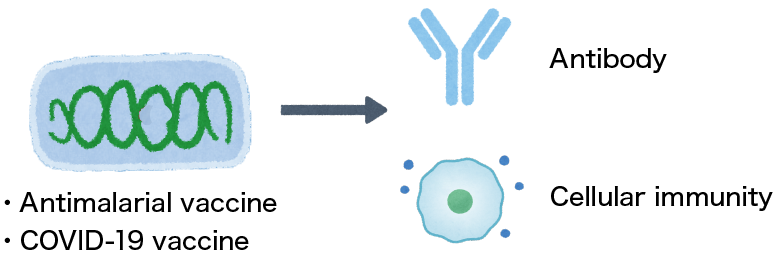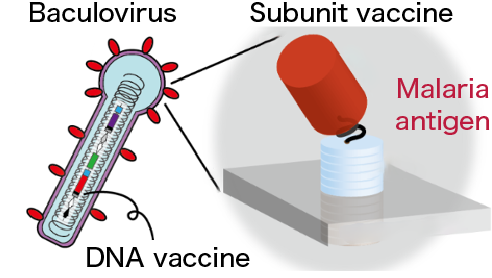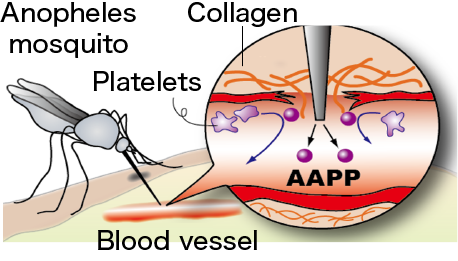Previous projects
Vaccinia virus-based antimalarial and COVID-19 vaccines

AAV-based antimalarial vaccine

Adeno-associated virus (AAV) is a proven gene transfer tool for gene therapy. Since foreign genes can be expressed in specific tissues for a long period of time, it is expected to be a vaccine vector with long-lasting effects. A malaria vaccine was developed using vaccinia virus (VV) and AAV as vectors, and when administered to mice in this order, the effect of blocking transmission lasted for more than 8 months. Based on this result, we would like to realize clinical application.
Baculovirus-based antimalarial vaccine

Although baculovirus (insect virus) shows high infectivity in mammalian cells, it does not proliferate. Therefore, it is used as a gene transfer tool with high safety profiles. By linking promoter for baculovirus with that for mammalian cells, a hybrid vaccine with the features of a subunit and DNA vaccine is be produced. When we developed an antimalarial vaccine and administered it to mice, it showed high protection against malaria parasites. When we developed a transmission-blocking vaccine and administered it to mice, transmission from mice to mosquitoes was effectively blocked. One of the reasons for such a high effect was the immunostimulatory effect peculiar to baculovirus. Combining protective and transmission-blocking vaccines will protect both individuals and populations.
Anopheline antiplatelet protein as an attractive antithrombotic agent

The saliva of blood-feeding animals, including mosquitoes, ticks, and bats, contains a mixture of molecules that inactivate or inhibit the hemostatic responses to the bite injury. Anopheline antiplatelet protein (AAPP), which was isolated from the salivary gland of a human malaria vector mosquito, exhibits a strong and specific inhibitory activity toward collagen-induced platelet aggregation. As compared with aspirin, AAPP exhibits a lower effect on hemostasis. Therefore, AAPP may be used as an attractive antithrombotic agent.

Vaccinia virus is a DNA virus that has been administered worldwide as a smallpox vaccine and has contributed to the eradication of smallpox. It is also useful as a gene transfer tool, allowing long DNA to be integrated into the viral gene. By incorporating the DNA from malaria parasites or SARS-CoV-2, we have created antimalarial or COVID-19 vaccines, respectively. When administered to mice, these vaccines elicited sufficient amounts of antibodies and cellular immunity. As mentioned above, vaccinia virus has been administered as a smallpox vaccine. Therefore, it has the advantage of being easy to proceed with clinical trials.